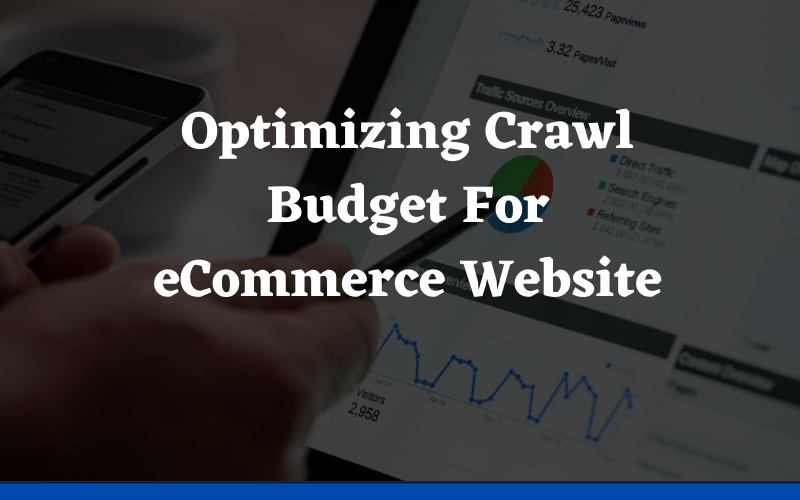
On a website, Google doesn’t spider all the pages instantly. Sometimes, it may take weeks to get it done. This may come in your way of SEO efforts, which may leave your newly optimized landing page un-indexed. Here, at this edge, a need for optimizing your crawl budget arises.
Today, in this post we are going to discuss what a crawl budget is, how a crawl budget is important along with some steps to optimize your crawl budget. So, let’s get started.
What Is A Crawl Budget?
The number of pages that Google is going to crawl on your eCommerce website on a given day is your crawl budget. Well, this number may vary slightly every day, but altogether, it’s much stable.
Per day, Google holds the caliber to crawl about 6 pages on your website, or 5,000 pages, or may even crawl 4,000,000. Your ‘budget’ and number of pages Google crawls is normally determined by your website’s size, its ‘health’, like how many issues Google encounters, and the number of links of your website. Some of such factors are the things one can influence.
Why Is The Crawl Budget Important?
When it comes to crawling budget, it assists in determining how rapidly your website pages start appearing in search. The chief issue here is that there may be a mismatch between the update rate of your site and the crawl budget. If this takes place, you will witness a flourishing lag between the second you make or update a page and the moment it starts appearing in search.
There are two possible reasons that would state that you are not obtaining enough crawl budget:
- One is Google doesn’t give importance to your website sufficiently. So, it either renders a worse user experience or is spammy, or perhaps both. Whichever be the case, it’s not much in scope where you can expect to publish better content and just wait for your reputation to enhance.
- Another is your site is overwhelmed with crawling traps. There are a few technical issues where the crawler may get stuck within a loop, may fail to get your pages, or may otherwise get discouraged from visiting your site. Here also, whichever be the case, you can perform well to enhance your crawling dramatically.
Should You Worry About Your Crawl Budget For An eCommerce Website?
Well, the crawl budget may emerge as an issue if you are running a medium or a large website at a frequent update rate. Here, the absence of a crawl budget may craft a permanent index lag.
This may be an issue while rolling out a new site or recrafting an old one and a lot of changes taking place quickly. However, this sort of crawling lag would eventually resolve itself.
While keeping aside the size of your site, it would be perfect to audit it at least once for possible crawling. If you are already running a big eCommerce website then you should do this now, on the contrary, if you own a smaller one, then you should place it on your to-do list.
How To Optimize Your Crawl Budget?
There exist a few things one should perform to motivate the search spiders to consume extra pages of your site and do this frequently.
Below is an action list that would help you in increasing the strength of your crawl budget:
Submit A Sitemap To Search Console
A document holding all the pages you need to be crawled and indexed in search is a sitemap.
With no sitemap, Google would be required to search the pages following the internal links of your website. This way, Google would take a while to get about the scope of your site and make a decision regarding which discovered pages should not be indexed and which should be.
With the assistance of sitemap, Google exactly knows how big your site is and which pages should be indexed. Moreover, there is an option in which you would be required to tell Google about the priority of every page and its update rate. With all such details, Google would be able to design the most apt crawling pattern for your site.
Resolve Crawling Conflicts
One more crawling issue is that Google thinks that crawling the pages is important than accessing them. In such a case, one of such things may take place:
- The page shouldn’t be crawled and Google had submitted it by mistake. Here, you need to un-submit that page either by deleting it from your sitemap or by removing the internal links to that page or possibly both the steps.
- The page needs to be crawled and by mistake, the access is denied. In such a case, you need to check what is actually blocking the access and fix that issue accordingly.
Well, whichever be the case, such mixed signals push Google into dead ends and allow your crawl budget to go waste unnecessarily. A perfect way to come up with and resolve such problems is by checking your Coverage report in Google Search Console.
Avoid Long Redirect Chains
If there exists an illogical number of 301 and 302 redirects in a row, the search engine will then stop going behind the redirects at any point, and the destination page may get un-crawled. So, just be sure that you consider using redirects not more than twice in a row, and just when it is much required.
Manage Dynamic URLs
A widely-known content management system produces various dynamic URLs, all that leads to the same page. Search engine bots by default will treat such URLs as separate pages. Resultantly, you may waste your crawl budget or/and may potentially breed duplicate content problems.
If the engine of your site or CMS appends parameters to the URLs that make the content of the pages stay uninfluenced, just be sure that you allow Google to know about it by handling such parameters in your Google Search Console account.
Resolve Duplicate Content Issues
Duplicate content means holding two or more pages with much similar content. This may happen because of many reasons. The dynamic URLs are one among them, or www/non-www versions, A/B testing, specifics of some CMS platforms, HTTP/HTTPS versions, and content syndication may also be. The issue with duplicate content is that you may waste your crawl budget, even double of it for the same piece of content.
● Optimize Site Structure
However, internal linking doesn’t hold a direct correlation with your crawl budget. As per Google, pages that are linked directly from your homepage may be considered as more important and crawled frequently.
Generally, it’s good advice to keep the significant areas of your website within the limits of three clicks from any page. Also, incorporate the most significant pages and categories in your website menu, featured products/posts, and sections with relevant products/posts that may be a great assistance for both search engines and users, in placing your landing pages there.
Conclusion
As you can witness, SEO is not all related to ‘reputable links’ and ‘valuable content’. When your website planning looks polished, it may be the right time to go down to the stairs and perform some spider hunting. It will surely prove to be magic in enhancing the performance of your website in search.
Now, as you hold the essential knowledge and instruments to tame search engine spiders perfectly, it’s time to move further and conduct the test yourself, and share the outcomes here with us.




More Stories
Grow Any Business : Email Marketing Services | 2024
Mobile SEO Guide: Ways to Improve Mobile Ranking
How Digital Marketing Actually Works